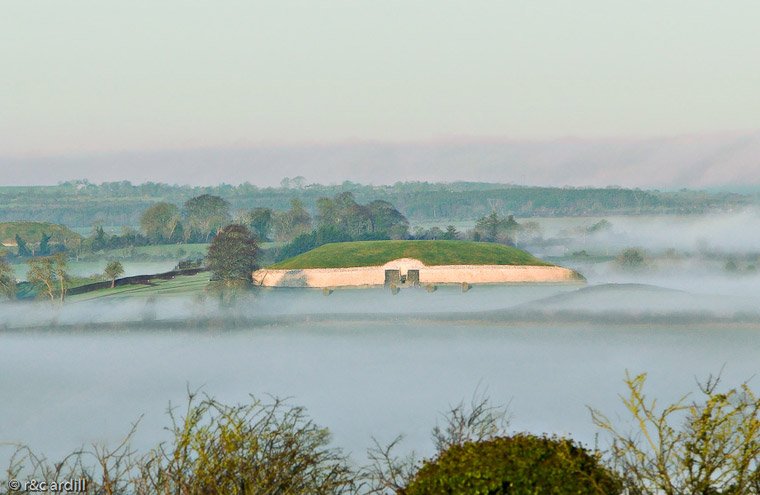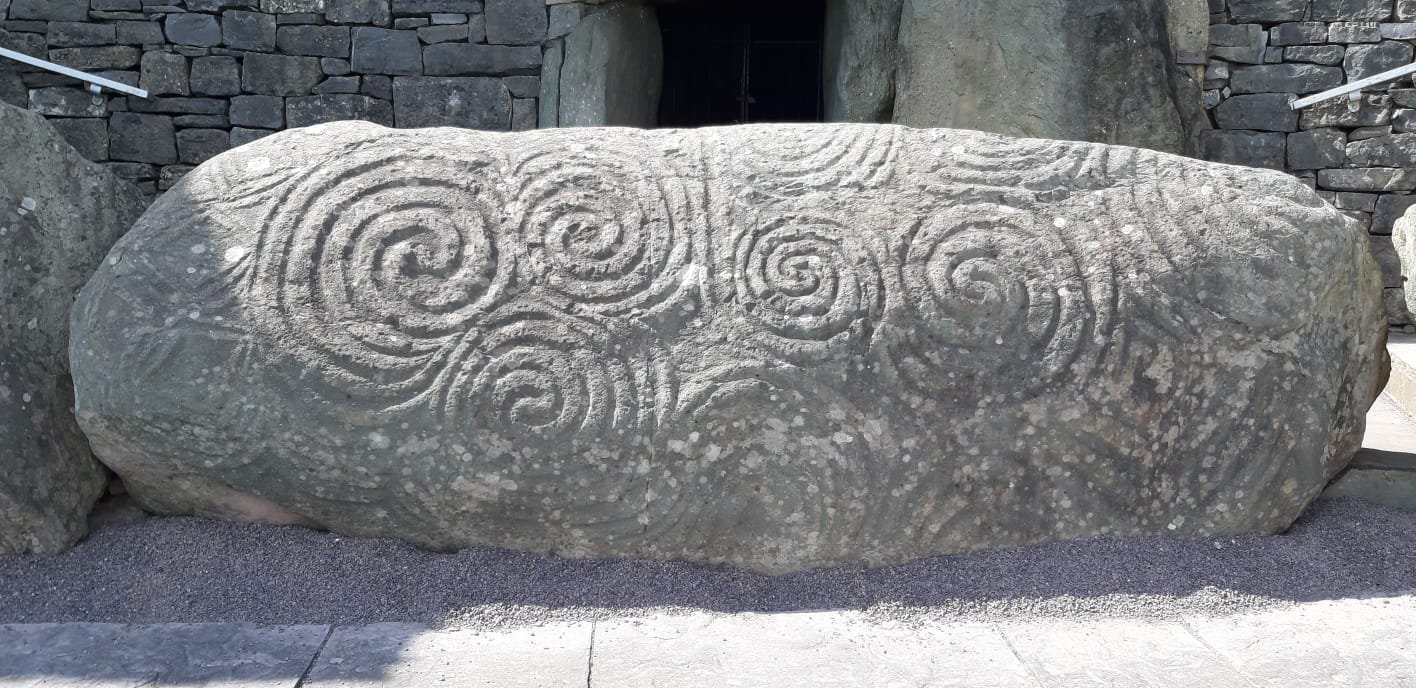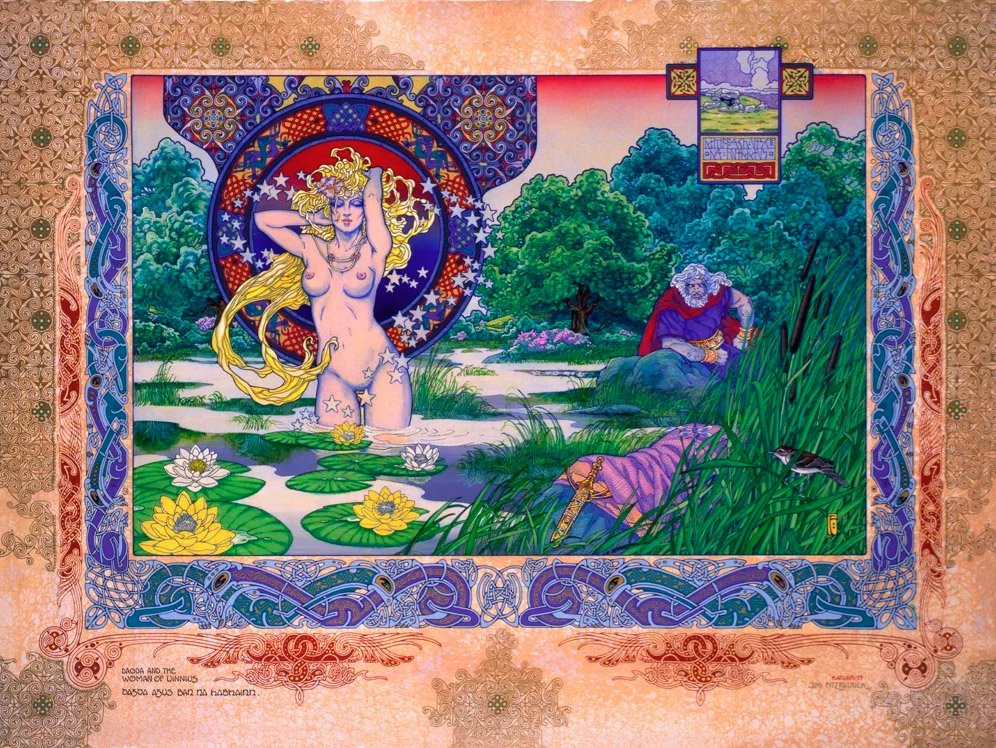
Brú na Bóinne
Brú na Bóinne is without a doubt one of Ireland’s most renowned complex of ancient temples - and the more greater known is that of Sídh an Bróga, (Newgrange) which aligns with the Winter Solstice sunrise. It is said that here is home to the Dagda, and Boann, two extremely important maternal & paternal deities of the Tuatha Dé Danann.
Tuatha Dé Danann - The Tuatha Dé are listed as the fifth race of settlers to arrive on the land of Éireann. It is said that they came North and West from the four cities of the Sídhe - Murias, Gorias, Finias, and Falias - of which they learnt the arts of Astronomy, Magic, Healing & Crafts. Their focus of learning was said to be in druidry ‘‘druidecht’’, knowledge, ‘‘fis’’, prophecy ‘‘fáitsine’’ and skill in magic ‘‘amainsecht’’. and they brought this wisdom with them when they landed on the Isle of Éireann. When the Tuatha Dé Danann came from the four cities, each of those cities brought with it a treasure. The four treasures are: the Sword of Nuada, the Spear of Lugh, the Cauldron of the Dagda, and the Lia Fáil (Stone of Destiny).
It is said that they arrived in the North-West of Connaught, to where they first built their ancient stone temple complexes in Sligo, tracking the movement of the sun, aswell as other astrological alignments.
Brú na Bóinne is a continuation of this legacy which is built around a thousand years after the first sites were built in Sligo.


Síd in Bróga
Síd in Bróga of the Boyne Valley - is the womb-like quartz covered ancient sun-temple, aligned with the midwinter Solstice sunrise, a site which is at the forefront as a symbol of Irish heritage, dated to be older than the pyramids of Giza. By modern-dating systems (which I question and don’t necessarily believe 100% as they have been proven wrong in recent times) Newgrange is said to be around 5,200 years old - built around 3,200 B.C. What we do know for sure, is it is very old indeed.
Síd in Broga - meaning the Mansion of the Sídhe/fairies. This mystical temple is at the heart of the Boyne Valley mythological centres. I feel even though this site has been here on this land for thousands of years - there was at some point, perhaps due to the introduction of roman catholicism, a discontinuation of relationship with the Brú. Perhaps it was when the Dé Danann were said to have gone underground, after the invasion of the Milesians? Or perhaps the sídh created a seal of protection, to hide away some of these sites from the church or other forces who would potentially seek to destroy them?
The Rediscovery of Síd in Bróga
Charles Campbell was the custodian of the land at Newgrange back in 1699, and it was a day he sent his workers to fetch some stones from the mound for building, that the magical entrance was revealed to them. In 1967 Professor M.J O’Kelly confirmed that the sun illuminates the chamber on the solstice, however, it is said that this was known already locally at this time.
What I do know, and feel in my bones, is that the land is calling the people back, more than ever - to remember our ancient connection with this sacred landscape, and the ancient wisdom which is encoded within it. In these times, year-after-year people in their hundreds gather on the day of the Solstice - to take the pilgrimage across land & sea - participating in this ancient phenomena, and if they’re lucky, the sun will break through the clouds and illuminate the chamber.
The significance: What is the significance of this architecturally exquisite stone temple? Is it just to keep track of the seasons?
Rebirth & renewal, return of the light
The time which precedes the Solstice, is one of the most darkness in all of the year. From Samhain onwards, it is a time where the landscape becomes increasingly more bare, trees shedding their leaves, the Cailleach’s frost kissing the landscape. Frosty winds, more rain, and darker/longer nights are promised. The light decreases day-by-day.
Samhain marking the true Pagan & Celtic new-year, (the ancient ones did not live by the modern gregorian calendar, they lived in a seasonal and astronomical way) And so, with Samhain, it is through the darkness we must enter, to begin a new cycle, shedding and purifying, to then to welcome a rebirth - a new dawn, and the mid-winter Solstice sunrise marks this renewal.
Around the 21st of December each year, the suns-rays penetrate & illuminate the chamber of Síd in Bróga. The actual inside chamber is womb-like in nature, with a cruciform narrow passage that breaks off left & right into two small side chambers. The darkness within the mound also similar to the womb, and could be regarded to be feminine in nature. The sun and light is often thought to be a masculine force, and in an Irish context this is reflected within the Dé Danann Sun-God Lugh, and possibly with Mac Gréine too. So it is in many ways that the masculine energy from the sun returns after the time of darkness and void, to bring fertility again to the Earth (the feminine). There is a reflection of the unification of the masculine and feminine energies contained within this act, and perhaps the ancients truly believed in and felt this - and that is why they built these temples to be so womb-like in nature. Perhaps they are intended to be like wombs of the Earth? It is interesting also that the Irish word for womb is ‘‘broinn’’ which holds similarities to Brú na Bóinne. In fact it almost looks like a combination of Brú and Bóinne together (just my thoughts). Anyways, it seems that these places are of course built to honour the solar deities & alignments but perhaps within that is an intrinsic honouring and worship of the feminine Earth Mother.
It makes sense in many ways that the sun (masculine) could be Dagda, and Newgrange being Boann’s womb, and from their unification is the conception of Aengus (rebirth of the sun). This makes more sense when we come into contact with the story of how Aengus is conceived.
I find it beautiful also that two of the greatest and least sad of love stories within Irish mythology are related to Brú na Bóinne. That firstly of Dagda & Bóann, and then Aengus & Caer. These love stories are my favourite in our mythologies and I also see them to be the most successful, and least tragic of all. I wonder why that is, and is there some of that essence and story held within the intention or coding of love held within Síd in Bróga/Brú na Bóinne?
That leads us on then, to the Dagda & Boann.

Dagda & Boann
Firstly, I will speak to both of these deities individually before offering a version of their shared mythos.
An Dagda
The Dagda is known by many names, the Good God, the Father, Eochaid Ollathair, (meaning the Allfather, or Horse Allfather), Fer Benn (the Horned One) Ruadh Rofhessa (Red man of Knowledge), Aedh Alainn (Beautiful Fiery One). Dagda is in many ways a leader and king-figure of the Dé Danann, and it is said that he reigned fruitfully for 80 years after Lugh was king.
He is a central figure in Irish mythology and cosmology. His most common referred name ‘‘the Good God’’ refers not necessarily to his behaviour, but to the great ability, skill and feat that he possesses. Not just a deity of one particular subject, the Dagda is a Father-like God who governs the seasons, fertility of the land & agriculture - he is a druid and a mystic, a musician and a bard. He is the master of many arts and he possesses multiple enchanted items which enhance his magical powers.
An Coire Ansic/Dagda’s cauldron: The Dagda’s cauldron was said to have come from the city of Murias. The Dagda’s cauldron of plenty would never run dry. There could be no want for satisfaction of food in the presence of it.
An Lorg Mór/the Great Club or Staff: An Lorg Mór of the Dagda is said to have been able to slay nine men with one strike of a side of the club/staff, it is also said to be able to resurrect the dead with the other side.
Uaithne/The Magic Harp: Dagda’s magical enchanted harp is said to be made out of Oak - and it is famous amongst our mythologies. It is a Harp that commands and weaves magic, only with his touch however. With uaithne he could command the seasons, and create music of the 3 noble strains - Suantraí, (a lullaby causing the listener to sleep), Goltraí (which would cause people to weep in sorrow) & Geantraí (a joyful air which would create laughter, dance, celebration).
Boann
It is impossible to speak about Brú na Bóinne and not mention Boann. Boann is the Goddess of the River Boyne, or Bóinn, and as the story goes it is she who transformed to become the Boyne itself. Her name can mean ‘‘white cow’’ coming from Bó (cow) Fhionn (white or fair). Her associations are that of the Mother, as cow-deities cross-culturally are often seen as maternal. She is a form or manifestation of Danú, the Mother of the Tuatha Dé - and Boann too is associated with fertility of the land. She is noted in the Lebor Gebála as sister of Befind, daughter of Delbáeth, son of Elada, of the Dé Danann. Her husband is Elcmar or Nechtan and her lover is the Dagda, together they conceieve Áengus. Boann was originally married to Elcmar/Nechtan and it is said that they lived Síd Nechtain, at the bottom of Carbury Hill.
Brief summary of how Boann became the Boyne:
In Co.Kildare at the foot of Carbury Hill, there lies an enchanted holy-well, which waters hold the memory and knowledge of all the worlds.
The Well of Segais had surrounding it 9 hazel trees, to which each year dropped their fruits simultaneously into the well. The wisdom contained therein these nuts infused the waters with wisdom and knowledge. It was in fact the Bradán Feasa (Salmon of Knowledge) who ate these nuts and recieved the wisdom of the worlds. It was said that whoever ate the salmon, drank the waters or nuts within the well, would recieve IMBAS (divine inspiration), unlocking perceptions and abilities to see through the veils and gain wisdom and knowledge of all things. It was forbidden for anyone other than the guardian of the well, Nechtan (Boanns husband) and his cup-bearers to have access to Segais.
A version of the story goes that Boann goes to the well, knowing that it is forbidden by her husband. There is an energetic enchantment upon the well and it refuses her to gaze unto it. She walks widdershins (anti-clockwise) around the well 3 times in an attempt to unlock the knowledge. Upon finishing her third lap the waters of the well rise up in anger and begin to chase her, and she runs fleet footed across the Boyne valley, only to be drowned by the waters and become the Boyne river itself.
I could go into a more in-depth analysis of this story alone, but I feel that is a venture for another day, as I could be here all week.
Boann & Dagda
concieve aengus Óg
* A note that this is one version of the story. In some sources Boann is married to Nechtan, others Elcmar. Some say Elcmar is Nechtan, and others compare him to Nuada, the king of the Dé Danann. In the creation story of the Boyne she is married to Nechtan and they live in Kildare. In this story she is married to Elcmar.
Boann and her husband Elcmar live in Brugh na Bóinne together. It is said that Elcmar was chief steward of the Dagda and judge of the Dé Danann. Distance grew between Boann and Elcmar and it was for Dagda that her love began to grow.
One day Elcmar had been sent off on a job by the Dagda. Boann had been bathing in a stream when she heard the music of the harp. She looked up and beneath an oak tree sat the Dagda, fiery and lustrous in his vigour- with sweet song emanating from his harp, opening Boann’s heart as she received each note that he plucked upon it. Her gaze fell unto him and they locked eyes, a recognition of love and a desire for union between them. They saw fully into one another’s souls and the love that had grown came forth and was known in an instance through their gaze. Boann’s cloak fell to the floor and she approached him, naked and bare in every dimension of her being. They made love and united in ecstasy. When they were finished, they wanted not to part ways so soon. So Dagda, with his magical harp Uaithne, commanded the sun to a stand-still. It stayed like that for a year and a day. Just aswell he did that, as it was from that love they shared that a child was conceived.
The sun stood still for the whole length of the pregnancy so that Boann could give birth without the knowledge of Elcmar. At the end of the 9th moon she birthed Aengus Macan Óc -who then became the God of Love. The Dindsenchas explains the name Aengus to mean ‘‘one desire’’ as Dagda was Boann’s one true desire. It was technically just for one day that they had their love too, even if it appeared to be for longer within the enchantment. This is what I was was getting at earlier within the significance of the solstice. Dagda (the masculine/sun) Boann’s womb (Brú na Bóinne) and (conception of Aengus), the rebirth of the sun. This trinity of creation is a huge part of pre-Celtic & Celtic cosmology, and is depicted INSIDE of the chamber of Síd in Bróga in the famous triskele. There is none other like that triskele in all of Ireland.
In the end Boann gives Aengus to the Dagda who brings him to Midir to be fostered where he will be safe and not known by Elcmar. Aengus later tricks the Elcmar into giving him Síd in Bróga to live in, and he then lives with his divine partner, the swan woman, Caer. But that’s a story for another day, which I promise I’ll come back to…
I hope that you enjoyed this post, the first of many I hope, where I discuss and share my love for Irish mythology and how these stories reflect the psyche of our ancestors and how the landscape in Ireland is one steeped in mythology and magic.
Le ghrá go léir ‘s beannaithe,
Aoife xx
Painting of brú na bóinne by Robert & Cathy Ardill.
Image of entrance stone by newgrange.com
Image of newgrange by Mythical Ireland (anthony murphy)
Boann & Dagda by Jim Fitzpatrick
Me with the triskele inside Síd in Bróga, photo by Pip Sheridan.


